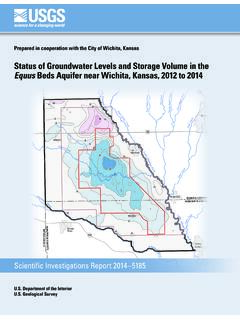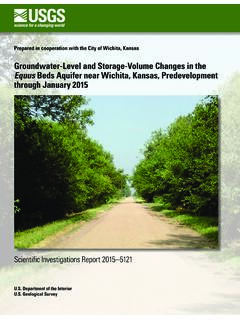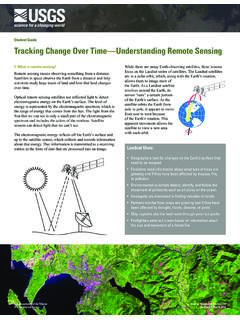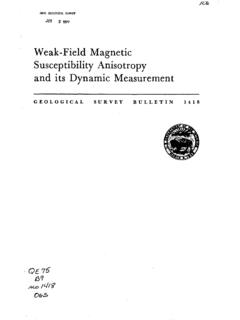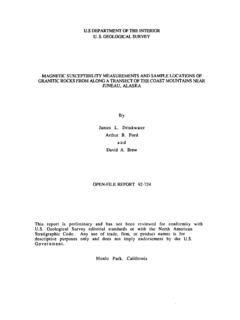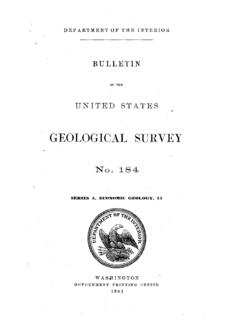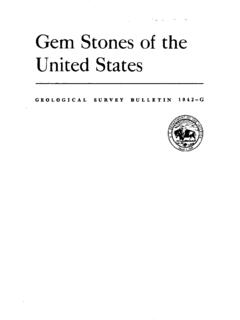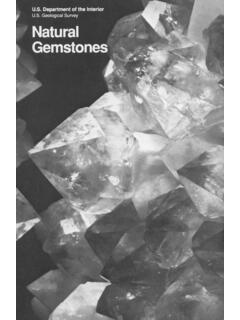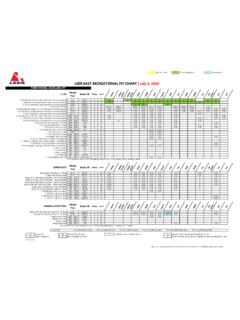Transcription of History of the Topographic Branch (Division) - USGS
1 History of the Topographic Branch (Division). Circular 1341. Department of the Interior Geological Survey Cover: Rodman holding stadia rod for topographer George S. Druhot near Job, W. Va., 1921. 2 Report Title John F. Steward, a member of the Powell Survey, in Glen Canyon, Colorado River. Shown with field equipment including gun, pick, map case, and canteen. Kane County, Utah, 1872. Photographs We have included these photographs as a separate section to illustrate some of the ideas and provide portraits of some of the people discussed. These photographs were not a part of the original document and are not the complete set that would be required to appropriately rep- resent the manuscript; rather, they are a sample of those available from the time period and History discussed.
2 Figure 1. The Aneroid barometer was used to measure differences in elevation. It was more convenient than the mercurial or Figure 2. The Odometer was used to measure distance traveled by counting the cistern barometer but less reliable. revolutions of a wheel (1871). Figure 3. The Berger theodolite was a precision instrument used Figure 4. Clarence King, the first Director of the Geological for measuring horizontal and vertical angles. Manufactured by Survey (1879 81). Berger & Sons, Boston (circa 1901). Figure 6. A Geological Survey pack train carries men and equipment up a steep slope while mapping the Mount Goddard, California, Quadrangle (circa 1907).
3 Figure 5. John Wesley Powell, the second Director of the Geological Survey (1881 94). Figure 8. Copper plate engraving of Topographic maps provided a permanent record. Figure 7. John Karl Hillers was the photographer with the Powell Surveys and later Chief Photographer of the Geological Figure 9. Geological Survey printing presses for use of Survey (circa 1890s). lithostones in printing Topographic maps. Figure 10. Topographic information was transferred from copper plates to a lithographic stone for printing. Figure 11. Plane table mounted on a Johnson tripod. Inset shows Johnson tripod head.
4 Figure 12. A 300-foot steel tape used for accurately measuring distances. Figure 13B. View of the Hooe Iron Building, Geological Survey headquarters, 1330 F. Street, NW., Washington, (1917). Figure 13A. Entrance to the Hooe Iron Building (1917). Figure 14. Bench marks were established with bronze-stemmed disks (left and middle) and caps (right) were stamped with a rounded elevation and placed by Geological Survey survey crews. Figure 15. When a structure was not available for cementing a stemmed disk, a 4-foot long wrought iron post with a bronze bench mark cap riveted to the top was planted by survey crews.
5 Figure 16. Henry Gannett, Geological Survey Chief Figure 17. Geological Survey flag with emblem, a design Geographer in 1882. He is often referred to as the father of consisting of a white triangle and crossed hammers encircled by American Topographic Mapping (1899). 13 stars on a blue field. Figure 18. A Keiffel & Esser high standard alidade was used in conjunction with a plane table. The inset shows detail of Beaman's ( Geological Survey topographer) improvement to the instrument, the Beaman Arc. Figure 19. Geological Survey field crew using an automobile. The Figure 20.
6 Shaded relief maps use the artistic Geological Survey first used automobiles in the field in 1914 (1918). illusion of depth to emphasize elevation. They were first employed by the Geological Survey in 1913. Figure 21. Geological Survey field crew (1952). Figure 22. A helicopter is used to transport a Geological Survey survey crew to a remote triangulation station in Utah (1953). Helicopters were first used in this capacity by the Geological Survey in 1948. Figure 23. Pen-and-ink drafting for map production was used Figure 24. The scribing method of map production supplanted from the early 1940s through the mid-1950s.
7 Inking contours by pen-and-ink drafting in the mid-1950s and produced a more legible hand required a light touch to maintain consistent line weight map in a shorter time, and at less cost. (1952). Figure 25. Convergent photography for map production employed stereoscopic models projected onto a tracing table. This allowed elevations to be determined with more accuracy, and at less cost, than former methods. Figure 26. Russell K. Bean of the Geological Survey patented the ER 55. stereoplotting instrument, which proved superior to the Multiplex plotter in the compilation phase of Topographic mapping.
8 History of the Topographic Branch (Division). By Richard T. Evans and Helen M. Frye Circular 1341. Department of the Interior Geological Survey Department of the Interior KEN SALAZAR, Secretary Geological Survey Suzette M. Kimball, Acting Director Geological Survey, Reston, Virginia: 2009. For more information on the usgs the Federal source for science about the Earth, its natural and living resources, natural hazards, and the environment, visit or call 1-888-ASK- usgs . For an overview of usgs information products, including maps, imagery, and publications, visit To order this and other usgs information products, visit Any use of trade, product, or firm names is for descriptive purposes only and does not imply endorsement by the Government.
9 Although this report is in the public domain, permission must be secured from the individual copyright owners to reproduce any copyrighted materials contained within this report. Suggested citation: Evans, , and Frye, , 2009, History of the Topographic Branch (division): Geological Survey Circular 1341, 196 p. ISBN 978 1 4113 2612 5. iii Foreword This History of the Topographic Branch is being published to provide a view of the Geological Survey ( usgs ) mapping program from its inception in the various Surveys of the 19th century to approximately 1954. The manuscript has existed as a draft document within the usgs .
10 Since 1955 with several unsuccessful attempts during the 1960s and 1970s to review it and make it more complete and up to date. We have chosen not to attempt to update the History for the years from 1955 to the present (2009), but rather to preserve the document as it was written in the 1950s. We have incorporated peer review comments that were developed in the 1960s and 1970s, and effort has been placed on maintaining the manuscript in the voice in which it was written with minor reorganizations to aid the reader in following the topical headings of the History . This manuscript utilizes a series of three asterisks separated by spaces (* * *) to indicate points of ellipsis.
